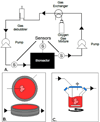Bioreactor design for perfusion-based, highly-vascularized organ regeneration
- PMID: 23542907
- PMCID: PMC3610919
- DOI: 10.1016/j.coche.2012.12.001
Bioreactor design for perfusion-based, highly-vascularized organ regeneration
Abstract
Bioartificial or laboratory-grown organs is a growing field centered on developing replacement organs and tissues to restore body function and providing a potential solution to the shortage of donor organs for transplantation. With the entry of engineered planar tissues, such as bladder and trachea, into clinical studies, an increasing focus is being given to designing complex, three-dimensional solid organs. As tissues become larger, thicker and more complex, the vascular network becomes crucial for supplying nutrients and maintaining viability and growth of the neo-organ. Perfusion decellularization, the process of removing cells from an entire organ, leaves the matrix of the vascular network intact. Organ engineering requires a delicate process of decellularization, sterilization, reseeding with appropriate cells, and organ maturation and stimulation to ensure optimal development. The design of bioreactors to facilitate this sequence of events has been refined to the extent that some bioartificial organs grown in these systems have been transplanted into recipient animals with sustained, though limited, function. This review focuses on the state-of-art in bioreactor development for perfusion-based bioartificial organs and highlights specific design components in need of further refinement.
Keywords: Bioreactors; Tissue engineering; bioartificial organs; organ transplantation; perfusion decellularization; regenerative medicine.
Figures


Similar articles
-
Comparison of methods for whole-organ decellularization in tissue engineering of bioartificial organs.Tissue Eng Part B Rev. 2013 Jun;19(3):194-208. doi: 10.1089/ten.TEB.2012.0340. Epub 2012 Dec 18. Tissue Eng Part B Rev. 2013. PMID: 23083305 Free PMC article. Review.
-
Building a Total Bioartificial Heart: Harnessing Nature to Overcome the Current Hurdles.Artif Organs. 2018 Oct;42(10):970-982. doi: 10.1111/aor.13336. Epub 2018 Oct 16. Artif Organs. 2018. PMID: 30044011
-
Perfusion-decellularization of human ear grafts enables ECM-based scaffolds for auricular vascularized composite tissue engineering.Acta Biomater. 2018 Jun;73:339-354. doi: 10.1016/j.actbio.2018.04.009. Epub 2018 Apr 11. Acta Biomater. 2018. PMID: 29654989
-
Cardiovascular tissue engineering I. Perfusion bioreactors: a review.J Long Term Eff Med Implants. 2006;16(2):111-30. doi: 10.1615/jlongtermeffmedimplants.v16.i2.10. J Long Term Eff Med Implants. 2006. PMID: 16700652 Review.
-
Bioengineered Livers: A New Tool for Drug Testing and a Promising Solution to Meet the Growing Demand for Donor Organs.Eur Surg Res. 2016;57(3-4):224-239. doi: 10.1159/000446211. Epub 2016 Jul 27. Eur Surg Res. 2016. PMID: 27459202 Review.
Cited by
-
Past, Present, and Future of Affinity-based Cell Separation Technologies.Acta Biomater. 2020 Aug;112:29-51. doi: 10.1016/j.actbio.2020.05.004. Epub 2020 May 19. Acta Biomater. 2020. PMID: 32442784 Free PMC article. Review.
-
Dried Rehmannia root protects against glutamate-induced cytotoxity to PC12 cells through energy metabolism-related pathways.Neural Regen Res. 2017 Aug;12(8):1338-1346. doi: 10.4103/1673-5374.213556. Neural Regen Res. 2017. PMID: 28966650 Free PMC article.
-
Two Decades of Advances and Limitations in Organ Recellularization.Curr Issues Mol Biol. 2024 Aug 22;46(8):9179-9214. doi: 10.3390/cimb46080543. Curr Issues Mol Biol. 2024. PMID: 39194760 Free PMC article. Review.
-
Ex Vivo Perfusion Using a Mathematical Modeled, Controlled Gas Exchange Self-Contained Bioreactor Can Maintain a Mouse Kidney for Seven Days.Cells. 2022 Jun 2;11(11):1822. doi: 10.3390/cells11111822. Cells. 2022. PMID: 35681517 Free PMC article.
-
Vascular Tissue Engineering: Building Perfusable Vasculature for Implantation.Curr Opin Chem Eng. 2014 Feb 1;3:68-74. doi: 10.1016/j.coche.2013.11.004. Curr Opin Chem Eng. 2014. PMID: 24533306 Free PMC article.
References
-
- Arcasoy SM, Kotloff RM. Lung transplantation. The New England journal of medicine. 1999;340(14):1081–1091. - PubMed
-
- Wertheim JA, Petrowsky H, Saab S, Kupiec-Weglinski JW, Busuttil RW. Major challenges limiting liver transplantation in the united states. American journal of transplantation : official journal of the American Society of Transplantation and the American Society of Transplant Surgeons. 2011;11(9):1773–1784. - PMC - PubMed
-
- Organ procurement and transplantation network. [Accessed December 1, 2012]; http://optn.transplant.hrsa.gov/.
-
- Baptista PM, Siddiqui MM, Lozier G, Rodriguez SR, Atala A, Soker S. The use of whole organ decellularization for the generation of a vascularized liver organoid. Hepatology. 2011;53(2):604–617. - PubMed
-
-
Soto-gutierrez A, Zhang L, Medberry C, Fukumitsu K, Faulk D, Jiang H, Reing J, Gramignoli R, Komori J, Ross M, Nagaya M, et al. A whole-organ regenerative medicine approach for liver replacement. Tissue engineering Part C, Methods. 2011;17(6):677–689. This paper evaluates different methods to recellularize the liver parenchyma of rats. Direct injection of hepatocytes in divided doses is shown to be the optimal method.
-
Grants and funding
LinkOut - more resources
Full Text Sources
Other Literature Sources
Research Materials
